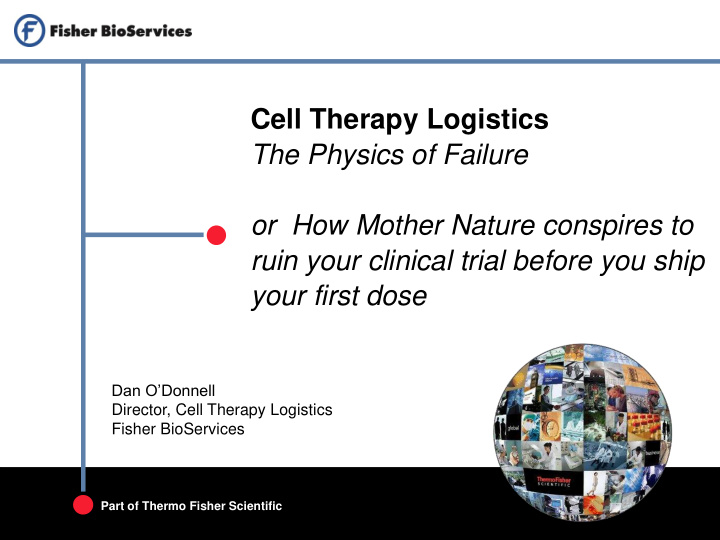



Cell Therapy Logistics The Physics of Failure or How Mother Nature conspires to ruin your clinical trial before you ship your first dose Dan O’Donnell Director, Cell Therapy Logistics Fisher BioServices Part of Thermo Fisher Scientific
Thermal Capacity • Thermal Capacity The measurable physical quantity of heat energy required to change the temperature of an object or body by a given amount. • Given the constituents of a shipping solution; Dry Shipper, Data Logger, Shipping Rack, Payload, Outer Container, Means and Conditions under which it ships. How long can an acceptable temperature maintained. The Challenge • In a world with an average temperature of 14 o C how do you maintain a temperature of -140 o C or less for an extended period of time? Proprietary & Confidential 2
Dry Shipper System Qualification Initial Qualification Avg 25 16.46 Days Minimum Acceptable Static Hold 14 Days at -150 O C Qualification w/Logger Avg. 15.27 Days 20 Qualification w/Logger and Payload Avg. 14.17 Days 15 Shipper failed 14 days temperature hold 10 5 0 Proprietary & Confidential 3
Gravity • Newton’s Law of Gravity The force that attracts a body toward the center of the earth, or toward any other physical body having mass. For most purposes Newton's laws of gravity apply • Dry Shippers & Gravity For our purposes it is the process that takes place when a carrier lays the dry shipper on it’s side or upside down during transit forcing the remaining LN2 to the side and out of the shipper reducing hold time dramatically Proprietary & Confidential 4
Orientation Risk • Why Orientation Matters • A shipper on its side for as little as 6 hours can lose 40% to 70% of its hold time • An inverted shipper can lose 60% to 90% of its hold time • The bigger the shipper the more rapid the loss of hold time • Orientation Risk Escalating Scenarios • This can be a serious concern if your product: • If the shipper experiences extended customs clearance times • Is in the dry shipper and is used for short term storage at the receiving site Proprietary & Confidential 5
Orientation Risk Mitigation • Labeling • Makes sense in theory does little in practice • Tilt Indicators • Always return actuated • Packaging Solutions • Secured to a pallet • Upright configurations • Orientation monitoring Devices • Cannot intervene but do let you know with some confidence level of the hold time remaining Proprietary & Confidential 6
Entropy • Lack of order or predictability; gradual decline into disorder • It Is The Gradual Deterioration of the Primary Constituents Of The Dry Shipper • Vacuum • Hydrophobic absorbent material which holds the LN 2 • Deterioration Can Be Caused Age And Damage Proprietary & Confidential 7
You Can’t Stop Entropy but… • You Can Test For It • Testing should be done on a regular basis • Highly recommended after each use • Monthly or Quarterly if used infrequently • Test when you suspect the unit has been damaged • Reduction in hold time • Visible damage • Handle with Care • Don’t drop or bang then around • Keep them cold • Don’t attempt to disinfect the interior chamber Proprietary & Confidential 8
You Can’t Stop Entropy but… • Test Levels • Set up regular interval for testing • Can be very sophisticated looking at a number of different variables IQ/OQ/PQ • Qualification Upon Receipt and then every 18 months • Weigh before every use • Measure against an established baseline • Recording your results will allow you to establish trends • Establish retirement policy • Universal, by project Proprietary & Confidential 9
The Gas Laws Laws that Govern the Movement and Temperature of Gases • Dalton's Law of Partial Pressures • The total pressure of a mixture of gases is equal to the sum of the partial pressures of the various components • Charles' Law • The Volume of a gas is directly proportional to the Temperature (Kelvin) at constant P and n. • Amonton's Law • The Pressure of a gas is directly proportional to the Temperature (Kelvin) at constant V and n. • Boyle's Law • The Pressure (P) of a gas is inversely proportional to Volume (V) at constant Temperature (T) and moles of gas (n). Proprietary & Confidential 10
The Gas Laws – Impact Highest Area of Impact Lowest Area of Impact Proprietary & Confidential 11
The Gas Laws Overcoming Adversity Rules to Minimize Impact • Position payload at the lowest possible level • Baffle to direct aspirated air away from the payload and probe • If the payload is low baffle to keep aspirated air high • If the payload is distributed through out the vessel force the aspirated air low • Package to protect the payload • Additional insulation is a plus • Map probe to payload • While protecting the payload is paramount but remember the data logger is reading the probe. Proprietary & Confidential 12
It is not Rocket Science but --- Source: Khooll.com by Jorge Lopez • Both involve living material traveling in a vessel with a controlled artificial environment surrounded by a hostile one • In both cases if you get the mission right 99% of the journey you still fail catastrophically Proprietary & Confidential 13
Reproducible Success is Possible • Precise Planning • Meticulous Preparation • Flawless Execution Proprietary & Confidential 14
eBooks and White Papers [InfoPoster] 10 Things You Should Know Cell Therapy eBook About Dry Shippers Before Shipping High Value Biologics Download at blog.fisherbioservices.com Proprietary & Confidential 15
Questions? Contact Us USA | UK | CH 1.301.315.8460 www.fisherbioservices.com Info.FisherBioServices@Thermofisher.com /Company/Fisher-BioServices Cell Therapy Solutions Learn more at www.fisherbioservices.com Proprietary & Confidential 16
Recommend
More recommend